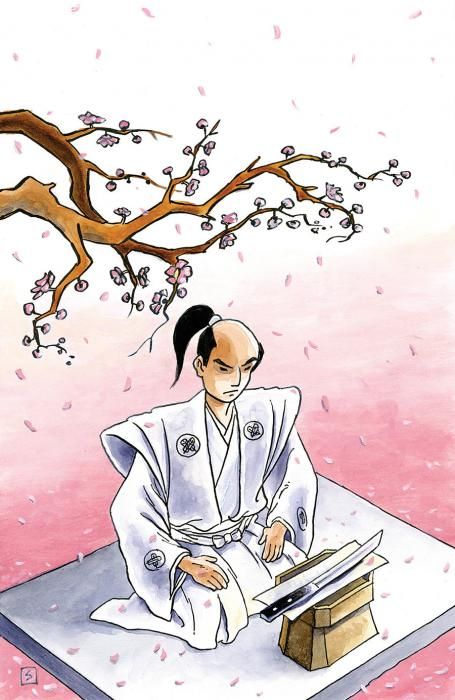"47 Ronin" #2 continues Mike Richardson and Stan Sakai's retelling of one of the classic legends of Japan, based in historical events but embellished by time and its status as a symbol for a nation. The story picks up speed as Lord Asano is ordered to commit seppuku, the catalytic event that will motivate those loyal to him to launch an epic revenge plot.
Richardson's pacing in "47 Ronin" #2 has a nice rhythm to it, and he jumps gracefully between two settings, Castle Ako and the Shogun's palace. Also, Richardson gives Asano's fate extra time and care, first informing readers of the material losses to Asano's estate and his samurai retainers, then heightening the stakes further by reminding readers that Asano is a family man. As cherry blossom petals fall down towards the condemned man, a single memory overwhelms him in a delicate and bittersweet scene.
Richardson also begins to focus more on Asano's group of samurai in Castle Ako, laying the foundation for the thematic heart of the legend -- a code of honor that emphasizes loyalty, duty and sacrifice.
"47 Ronin" #2 has a lot more suspense than the debut issue, but much of this narrative tension is intrinsic to the legend. The story's fascination has endured for centuries. It is hugely popular, and the number of retellings in plays, prose, film and television must number in the hundreds.
Richardson's plotting is fine, but unspectacular. With the exception of Asano's death, he sticks strictly to action, revealing the focal events within the palace intrigue competently and clearly. Unfortunately, apart from making Asano a sympathetic victim of the villainous Kira, Richardson doesn't add much of his own spin or bring a deeper resonance or analysis of events to the material. Richardson juggles the large cast and interlocking plot mechanics fine, and he's doing a good thing by bringing this material to an American comics audience, but despite his long-running passion for the story, his script lacks flair.
The biggest problem is that Richardson's dialogue seems to exist to serve the action in a slightly forced way. Other than Asano, his characters are chess pieces that propel the plot, with relatively simple, transparent motives announced to the reader within a few moments of their introduction.
In contrast, Stan Sakai's art in "47 Ronin" #2 is minimalist and cartoony but emotionally effective, like his work for "Usagi Yojimbo." His characters' faces usually just have dots and lines for their facial features, yet the facial expressions still have great depth and range. In the scene with falling cherry blossoms, as Asano walks towards his death, Sakai's page and panel composition is elegant and poignant. Lovern Kindzierski's coloring sets off the pink cherry blossoms with a pale blue-green sky that looks like watercolor, pure and luminous as glass but also fragile-looking, reinforcing the scene's melancholy and wistfulness.
Directly after Asano's act of seppuku, Sakai's full page panel has three black birds, their flight path arcing over a landscape full of distant little people, the last bird looming close to the reader and emphasizing the bird's eye view of Castle Ako. This one page by Sakai by itself captures the legend's unique atmosphere. Its dominant drives of justice and fate create a mixture of menace and balance, of ominous tension countered by a calmness borne of inevitability.
"47 Ronin" #2 is a worthwhile read, but I have to agree with fellow reviewer Greg McElhatton's observation about "47 Ronin" #1, that the writing (still) needs to catch up to the art.

